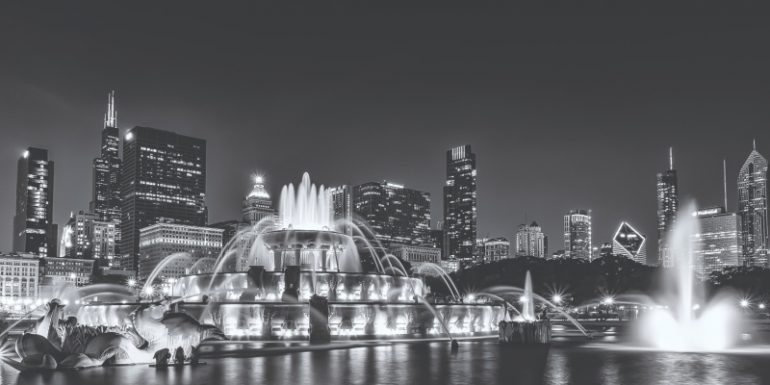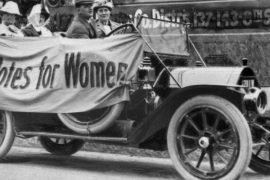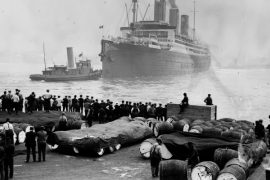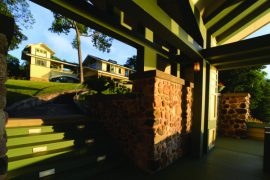By Sarah T. Lahey
Buckingham Fountain, in Chicago’s Grant Park, is referred to in Chicago Park District information as the centerpiece of the city’s “front yard.” If you’ve ever wondered about its history, look no further than Lake Geneva. To fully understand the connection, we have to start by revisiting the genealogy of a family, one that includes some of Chicago’s 19th century movers and shakers, and several who summered on Geneva Lake.
The first mansion on the lake was built in 1871 by Shelton Sturges, son of Solomon Sturges, who made a fortune in the grain storage business. The Sturgeses became a sort of “first family” in Lake Geneva, eventually owning three estates and marrying into other lake families. The family’s inheritance was sizable, and they always aimed to put it to good use. Mary D. Sturges, for one, donated land to the Village of Geneva, creating the public library and Elm Park. Her niece, Kate Sturges Buckingham, used her inheritance to fund Chicago’s Art Institute, Lyric Opera and — last, but not least — Buckingham Fountain.
GRAIN “KINGS” OF CHICAGO
It all started with Solomon Sturges and his business partner, Ebenezer Buckingham Jr., who happened to be his brother-in-law (married to Sarah Sturges). Solomon and Ebenezer ran a successful mercantile business in Ohio before moving their families to Chicago, where they hoped to make a start in the grain business. In 1855, they built the first large- capacity grain elevator in Chicago, holding more than 700,000 bushels. This was an innovation and the two men cornered the industry for nearly a decade. The Great Chicago Fire of 1871 later provided an unexpected advantage when all the grain elevators in the city were destroyed except one belonging to Sturges & Sons. This stroke of luck solidified the family’s wealth — on both the Buckingham and Sturges sides.
THE STURGES DYNASTY
Although several families have held claim to being “dynasties” on Geneva Lake, the Sturges family was the first. Solomon Sturges died in 1864, leaving his children (all nine of them) with a family business to run. It is no wonder they went looking for a place to enjoy a break from their daily responsibilities. In 1870, Shelton Sturges, the second-eldest son, visited Lake Geneva to evaluate the merits of purchasing land. According to local historians Ann Wolfmeyer and Mary Burns Gage, Shelton would have seen “mile after mile of dense woods broken only by a small cluster of homes marking Williams Bay and the Village of Geneva” — then boasting a population of barely over 1,000. Shelton selected Montague Farm, which would become the lake’s first opulent estate: Maple Lawn.
Shelton Sturges finished construction of Maple Lawn during the summer of 1871, a few weeks prior to the completion of the train line from Chicago to Lake Geneva. His brother, Buckingham, took over the Montague farmhouse and another brother, George, rented a small house in town. With three Sturges siblings settled (all with kids), they nearly took over the village. Locals were appeased when Shelton built a large reservoir to serve as a back-up water supply. In 1874, Shelton and his wife, Frances, further amused villagers with the construction of a large fountain on the grounds of Maple Lawn that shot water 40 feet into the air. This fountain might have inspired Chicago’s Buckingham fountain, later constructed by their niece, Kate.
The Sturges family, by all accounts, became embedded in the life of Lake Geneva. They were members of the Geneva Episcopal church, active in village politics and hosted concerts at Maple Lawn every Saturday night in the summer. According to Wolfmeyer and Gage, “the young ladies sang selections of church music” and the “young men and their cousins kept the guests comfortable.” With more than 20 Sturges cousins running around, it would have been hard to keep track of them.
Shelton’s brother, Buckingham, spent 10 summers at the Montague farm- house before building his own estate just inland from Maple Lawn. Named Fairfields, this estate included 20 acres and a 15-room mansion. Even more impressive, the estate remained in the family until 1955, when the last of Buckingham’s children, Kate B. Sturges, passed away. As the last survivor of Buckingham Sturges, Kate donated more than 1,200 books to the Lake Geneva Public Library.
The flashiest Sturges brother was George, whose wife, Mary Delafield Sturges, was a star in her own right. Together, they built Snug Harbor, a large mansion situated west of Maple Lawn. It was completed in 1881, 10 years after Shelton built the first estate. The intervening decade was spent in a cottage in town, which eventually became the Lake Geneva Public Library. The family loved the cottage and its adjoining land, and Mary Sturges was very clear in her gift that it would be “forever for the uses of a Public Park and Public Library.”
LOVE AND MARRIAGE
Kate Sturges Buckingham, creator of Chicago’s celebrated Buckingham Fountain, was one of the myriad Sturges family cousins running around the estates on Geneva Lake. Her mother was Lucy Sturges, who married Ebenezer Buckingham III on May 5, 1853. Young Ebenezer Buckingham’s father was the business partner of Solomon Sturges, Lucy’s father. To add another twist to the story, the elder Buckingham was married twice — first to Sarah Sturges and then to Eunice Hale. Ebenezer III was the child of the second union.
Lucy and Ebenezer III owned property in Lake Geneva, although they never built an estate. There is reason to believe they spent considerable time at the lake, given the close bonds among the Sturges. The family attended Shelton’s opening party for Maple Lawn, and young Kate would have seen the fountain that graced the property over the years. It is also likely that Lucy and Ebenezer stayed at Lake Geneva after the Great Chicago Fire, since their home had been completely destroyed. Their new home on Chicago’s Prairie Avenue took nearly four years to complete, so why not escape to Wisconsin?
KATE’S EARLY YEARS
As a Sturges-Buckingham heir, Kate grew up amid great privilege. She had private tutors and fine dresses, but — at the same time — lacked the social ease of a normal childhood. Her siblings became her best friends, especially her brother Clarence. She was 13 when the Chicago Fire destroyed the family home, and it transformed her into a young activist. Two years later, she was raising funds for the children’s wing at Cook County Hospital.
Kate’s family re-established themselves on Prairie Avenue by 1875, and her father’s business continued to do well. In 1882, her parents built a second home in Lake Forest, Illinois. Visiting this estate likely kept them from Lake Geneva, although one assumes they still visited uncles Shelton, Buckingham and George, and their families from time to time.
ONE OF CHICAGO’S WEALTHIEST WOMEN
As the years went on, Kate’s wealth increased, but she found herself increasingly alone. In 1889, her mother died. Her sister, Lucy Maud, was disabled her entire life. Kate — by her own choice — never married. When she lost her father in 1912 and her brother one year later, life as she knew it changed forever.
At age 55, Kate became the sole beneficiary of $4 million — approximately $70 million today. She wielded a vast amount of money and had no husband to interfere. How to spend it? The decision came down to her passions. Kate Buckingham loved three things: fine art, her family and the city of Chicago.
DONATING TO THE ARTS
Kate and her brother Clarence spent much of their youth traveling around the world. Clarence had a passion for Asian art, collecting thousands of Japanese prints that he regularly displayed at the Art Institute of Chicago. After her brother’s death, Kate became more proactive and donated her collection of medieval art to the Institute. In 1925, she established the Clarence Buckingham Collection that contained over 2,000 works. As celebrated in her obituary, Kate Buckingham was “godmother” to the Art Institute.
She also supported the Lyric Opera in her later years. The Chicago Tribune described her: “Tall, regal, with her white hair worn still in a Queen Mary pompadour, she was a frequent attendant at the opera, usually accompanied by one or several of her young protégés.” The old- fashioned Kate Sturges Buckingham did not embrace the jazz music of the 1920s, but she believed in opera. Her protégés were some of her closest friends, at least in her later decades, since she had long removed her name from the social register and shunned most of society.
When Kate Buckingham died in 1937, she left a half-million dollars to friends and relatives. She also left $126,000 to her maid, chauffeur, caretaker and nurses. That left $3.1 million for charity, including a $2 million donation to the Art Institute. She was a generous woman and unstoppable patron of the arts. Yet, she remained humble to the end, saying to a friend, “I never did anything more than I should as a Chicagoan!”
THE MAKING OF BUCKINGHAM FOUNTAIN
Situated in Grant Park, along the shores of Lake Michigan, Buckingham Fountain remains Kate’s greatest creation. She envisioned the entire project — from start to finish — including the French design, colored lights and music, and the endowment needed to maintain the fountain.
She dedicated the fountain to the most treasured person in her life: her brother. The Clarence F. Buckingham Memorial Fountain remains one of the largest of its kind, standing four times larger than the Latona Fountain at Versailles, after which it was modeled. It contains 1.5 million gallons of water and more than 200 jets. She first proposed the fountain in 1924, at an estimated cost of $250,000. Three years later, her dream was a reality — with a new price tag of $750,000.
James Bennett of the Chicago Tribune penned a now-famous description of Buckingham Fountain after its unveiling. He wrote: “In a week the Buckingham fountain has captured the imagination of the town, enlarged its aesthetic sense, and done it spiritual good. The gift is more than a memorial to Clarence Buckingham … it is the lyric of the lake.”
THE STURGES- BUCKINGHAM LEGACY
Kate’s magnificent fountain may, or may not, have gleaned inspiration from the fountain at Maple Lawn and childhood summers at Lake Geneva. It is likely that trips to Europe and the gardens at Versailles held stronger sway. However, one thing is certain: the Sturges family was a close-knit group that believed in giving back to the community. Solomon Sturges did not live to see Buckingham Fountain created, but he and Ebenezer – the grain “kings” of Chicago – would have been proud to see their granddaughter serving the public good.





